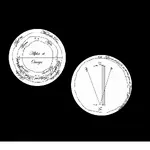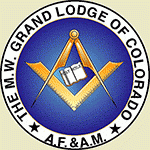The front seems to say in Latin "Glory (gloria) is both (et) to divide (divide) to (in) conquer (domo) all (omne, not yuo or guo, m's sometimes have a longer first stroke that hangs below the line), and (et) justice (iustitia, no "j" in classical latin, really an "i", meaning this medallion is modern) for all (omne) the ages (seculum, from saeculum)."
Just a guess. I'm more of a Greek guy than a Latin guy.
The second side seems to represent a very gnostic view of the spiritual universe with the "Alpha and Omega" (First and Last) in the center of concentric circles. The next circle gives some common Hebraic and Apocryphal names of God (Adonai, Elohim, Udonai, and as mentioned previously, AGLA). The maker of this medallios did not, however, seem to see these as names of God, but rather as four god-like beings separate from the Alpha and Omega. Very gnostic. The third circle mentions angels that are called archangels elsewhere (from the Apocrypha mostly), and the last circle seems to name great human leaders (Modiath is very close to the Hebrew for Medes, making Modiath Rex "King of the Medes"). This gnostic view of spirtual authority and power goes way back, but is still around today in a lot of spiritual thinking. Here it seems to have been mixed with orthodox Christian symbols on the front of the coin (the seven lamps of God's Spirit from the Torah, or Old Testament) combined with a trinitarian triangle with crosses. This synchrenistic gnosticism is quite common in pagan religions and cults.
Just some thoughts,
RedSpey




 not likely. Didn't have a chance to scan it yet. I don't own a scanner myself but my mate has one. Found the medallion from London where I worked. Somebodys misfortune became my fortune. I hope it's a money medallion because I've always been unlucky with money (did the lottely for saturday)
not likely. Didn't have a chance to scan it yet. I don't own a scanner myself but my mate has one. Found the medallion from London where I worked. Somebodys misfortune became my fortune. I hope it's a money medallion because I've always been unlucky with money (did the lottely for saturday)


 Conspiracy theory stuff
Conspiracy theory stuff You are thinkin about Russia in which Finnish people aren't very keen on..
You are thinkin about Russia in which Finnish people aren't very keen on.. 



